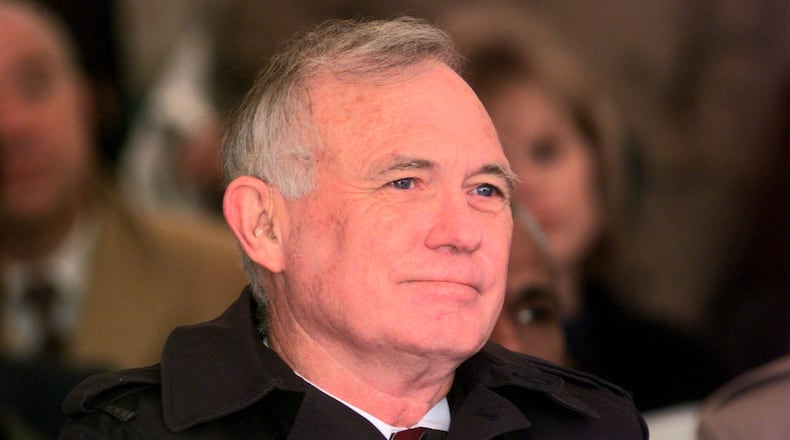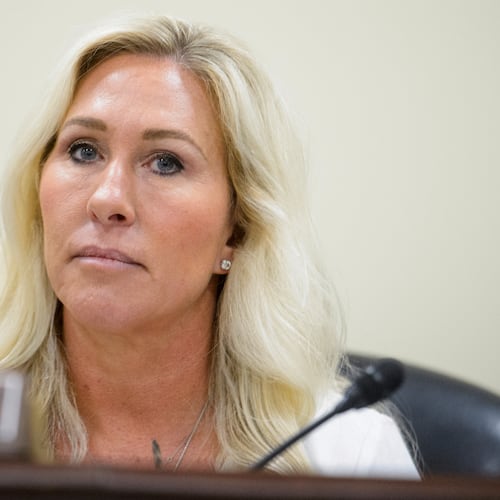Where Interstates 85 and 285 converge on Atlanta’s Northside, a traffic reporter flying overhead once commented that the 11-mile swirl of on-and-off ramps looked like an “overturned bowl of spaghetti.”
“I think I’ll start calling it ‘Spaghetti Junction,’” reporter Dave Straub said.
Although the nickname stuck, the Georgia Department of Transportation board thought better and named it the “Tom Moreland Interchange” for the powerful man behind that project and almost every significant highway improvement in Georgia for decades.
“Tom was the architect of the modern highway system that we have in Georgia,” former Gov. Roy Barnes said. “He was a fixture for years; you see his work everywhere. You name it; he built it.”
Tom Moreland, the powerful head of the Georgia Department of Transportation from 1975 to 1987 and later co-founder of a successful road engineering firm, died Monday. He turned 90 earlier this month.
Family members said Moreland entered the hospital in early July for treatment of an infection and later atrial fibrillation, or Afib, an abnormal heartbeat. About two years ago, he was diagnosed with myasthenia gravis, an autoimmune disease that affects communication between nerves and muscles and may have contributed to his death, daughter Vickie Moreland said.
In a statement issued late Monday, the Georgia Department of Transportation said Moreland’s “impact on transportation in Georgia is immeasurable.”
Moreland spent more than 30 years at GDOT, including five years as its chief engineer and another 12 in the dual role of chief engineer and commissioner. During his tenure, the department had 6,000 employees and an annual budget exceeding $1 billion.
During his tenure he oversaw some of the state’s most significant transportation projects, including many that define Atlanta, some of which had bitter opposition because of what they did to neighborhoods. Among the roads are Atlanta’s Downtown Connector, which he and then Atlanta Mayor Maynard Jackson partnered on in a campaign called “Freeing the Freeways,” also Ga. 400 and a portion of Peachtree Industrial Boulevard, which was turned into a mini highway.
Statewide, he oversaw the creation of a series of developmental highways to encourage growth in Georgia’s rural and economically depressed areas.
His daughter said that one of the proudest achievements of his career was the completion of the federal interstate system through Georgia. The last stretch of that work was considered complete in 1978, a DOT spokesman said.
Moreland’s appointment as commissioner was billed as a signal of a new era at the DOT. His predecessors — including Jim Gillis and Bert Lance — were political appointees with no formal training as engineers.
By contrast, he had a bachelor’s and master’s degree in civil engineering from Georgia Tech and was the first employee to work his way up to commissioner from his start working summer laborer jobs in his late teens, Vickie Moreland said.
Tom Moreland was widely considered a highly skilled engineer but had his own hard-nosed style and critics. For example, in 1985, then-House Speaker Tom Murphy accused Moreland of setting “himself up as the fourth branch” of state government.
“Tom was tough. You never got anything from Tom unless he got from you,” said Barnes, a longtime legislator and Georgia’s governor from 1999 to 2003.
Credit: Billy Downs
Credit: Billy Downs
Retired journalist Bert Roughton, who covered Moreland during his tenure with the DOT for The Atlanta Journal-Constitution, said Moreland came “from the mold of the old highway chiefs, which in Georgia for generations — or since cars have been on the road — was among one of the most powerful and influential positions in the state.”
Local elected officials from around the state knew they had to come to DOT headquarters in Atlanta to personally plead with him if they needed a road built in their community.
“You had to kiss his ring. That was his reputation,” Roughton said. “It was almost common place that, if you wanted a road, you had to make him happy.”
Moreland was born in Chatsworth, in Northwest Georgia’s Murray County. His high school in Murray County only went through the 11th grade. He attended North Georgia College for two years on an ROTC scholarship before transferring to Georgia Tech, his family said.
He graduated with honors from Georgia Tech, where he formed a lifelong bond with classmate Danny Altobelli from Brooklyn, New York, who would later become his partner in the engineering firm Moreland Altobelli Associates, Inc.
“He was a self-made man, no question about it,” Barnes said.
While he was commissioner, Moreland also served for more than a decade on the MARTA board. He was nationally recognized as a leader in transportation, serving as president of the American Association of State Highway and Transportation Officials (AASHTO) and as vice chair of the U.S. Transportation Research Board.
Moreland retired from the Georgia DOT in 1987, just as Altobelli was winding down his career with the Federal Highway Administration. They formed their company and quickly capitalized on a change in state law that allowed local governments to impose a special purpose local option sales tax, or SPLOST, to pay for road projects. Fast-growing Gwinnett County was one of Moreland Altobelli’s first SPLOST clients.
Vickie Moreland, the firm’s chief financial officer, said, “I think the passage of {the SPLOST law] really contributed to the (firm’s) success.”
Altobelli died in the 1990s. Moreland continued to work full-time at the firm until he sold it in 2017 and retired at 84, his daughter said.
Moreland moved to a 50-acre cattle farm in Gwinnett County in 1996, where, until recently, he bailed hay and drove a tractor. He also spent most of the last 3 and 1/2 years caring for Evelyn Kilgore Moreland, who has a disabling brain injury. The two married in 1954, his family said.
Daughter Vickie said her father loved taking the family across the country in their station wagons, staying in tents for a couple of days, and then moving on to the next adventure. He had a walking horse and would take the family on trail rides.
“He was a great dad,” she said.
Moreland is survived by his wife Evelyn; his children Steve Moreland (Allison); Vickie Moreland. Melissa Bourbeau (Brian), and Holly Moreland; grandchildren Laura Evelyn Sack, Tom Moreland-Smith, Clancy and Bonner Bourbeau; grandchild Adalyn Moreland; and sister Sandra Stewart.
A service is planned for 2 p.m. Thursday at Sugar Hill Church with a private family burial to follow. A visitation will be held from 4 p.m. to 7 p.m. Wednesday at Crowell Funeral Home in Buford.
About the Author
Keep Reading
The Latest
Featured




